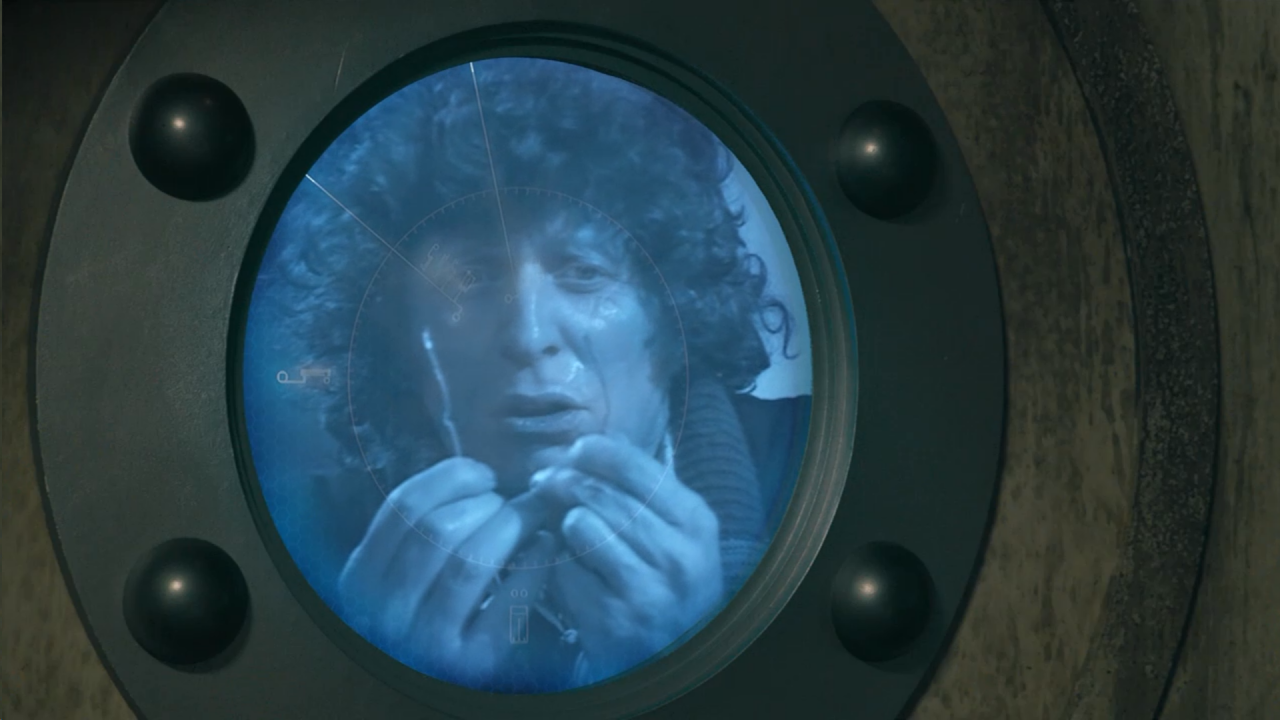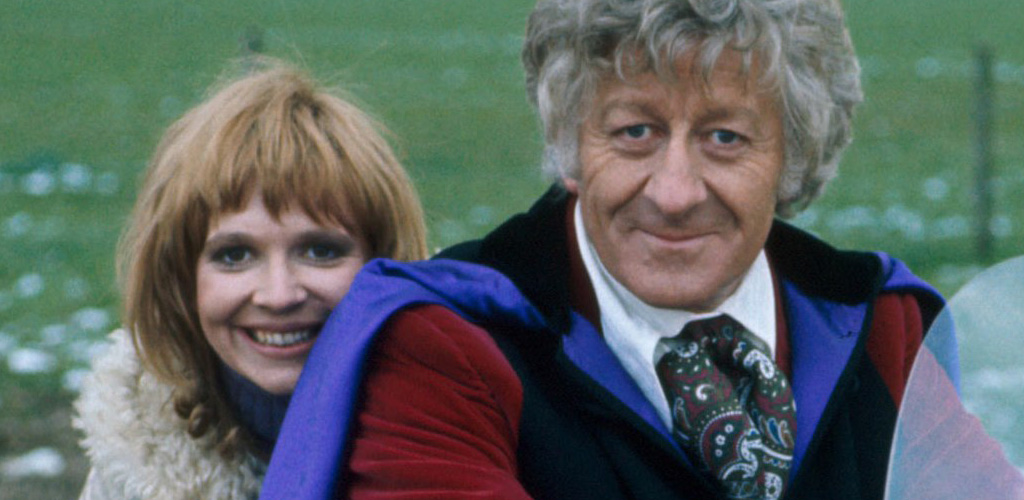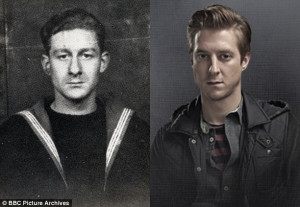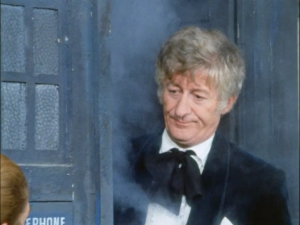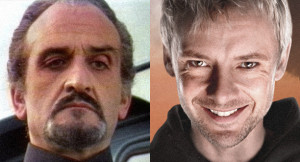Series 9 of Doctor Who started off with a bang, delivering the good, the bad and the WTF we’ve come to expect. “The Magician’s Apprentice” is half of a 2-part story. Here’s what I got out of the season’s big premiere.
Have You Ever Seen a Hand Mine?
When done well, the time travel genre can express character transformation. Look what it did for Phil Connors in Groundhog Day. This might be the best example of the Doctor “making his own monster” since The Face of Evil.
Of course Kanzo, the compassionate black soldier, had to die saving the cute white kid. As a product of British culture, Doctor Who has always been tone-deaf to race. Tomb of the Cybermen has the big, dumb, black manservant Toberman. The Talons of Weng-Chiang (fourth Doctor) and Four to Doomsday (fifth Doctor) use the term “china man” as tool of oppression. Even in the Russell T Davies era “The Shakespeare Code ,” the Doctor dismisses Martha’s logical concerns about becoming a slave (which was later picked up in “Human Nature”/”Family of Blood.“)
“Hand mine” is a great pun. I thought the creatures were a copy of that child-eating monster from Pan’s Labyrinth (2006) Turns out that was inspired by Tenome, a mythical creature from the Japanese picture book series Gazu Hyakki Yakō (“The Illustrated Night Parade of A Hundred Demons,” published in 1776.)
Davros Remembers
The Maldovarian bar scene is a sustained cliché. Was that Figrin D’an and the Modal Nodes playing “My Angel Put the Devil in Me” in the background? Like Pepperidge Farm, Davros remembers. But why does he send Colony Sarff all over the universe like an intergalactic thug-a-gram? “Tell me what I want to know, or I’ll do something…cinematic!” He should’ve called the Twelfth Cyber Legion; they seemed to know everything in A Good Man Goes To War” (written by Steven Moffat). Davros could have delivered his cryptic message more efficiently with email, chat, or GoToMeeting.
Then there’s the “super powered servant” cliché. The earliest example I can think of is Silver Surfer (Fantastic Four #48–50, 1966). The Surfer, however, did reconnaissance for a real “destroyer of worlds.” Colony Sarff is more pointless than Luca Brasi.
Why can’t the Doctor have super powered companions?
What are Colony Sarff’s superpowers, anyway? They seem like the Mara from Kinda, who could manipulate the weakened Davros. How’d he get past those scary Judoon to break into the Shadow Proclamation? In typical new Who plot sloppiness, show runners hope the scene is too awesome for us to care how it happened…or that we don’t remember past episodes. It’s like they don’t know their audience.
It Saves Time
The banter between the Doctor and High Priestess Ohila was terrific. Although she wasn’t alive when the fourth Doctor met the Sisterhood in The Brain of Morbius, their personal friendship seems almost that long. She certainly isn’t fazed by his compulsive lying. Her plea shows a sad, helpless frustration of not being able to stop a loved one from self-destruction. Quoting a Rilo Kiley line, the Doctor seemed as “ready to go” as he did at the end of Planet of the Spiders. Moffat being Moffat, he almost ruined this with his sappy “you can never lose a friend” line.
It’s too bad Moffat decided the High Priestess couldn’t be Ohica, played by Gillian Brown in The Brain of Morbius. Hiring Ms. Brown to reprise the role would have been a nice touch.
#ThePlanesHaveStopped
Clara Oswald is still a horrible teacher. How would “Jane Austin’s a phenomenal kisser” not get her fired? A real teacher wouldn’t have time for Danny or the Doctor. In a credibility nose-dive from An Unearthly Child, last season’s portrayal of teaching is less believable than time travel and “little blue men with three heads.”
Without turning the show into Room 222 or The Secret Life of the American Teenager, this could have been fixed by giving each story a brief moment to Clara’s job preparation. She could have graded on the TARDIS, bounced ideas off P.E. over dinner, or confided with her grandmother (which would have made amazing for both generations of independent women).
UNIT is just as clumsy and indiscrete as they were under the Brig. Those morons outed Clara as a government operative. I’m beginning to think the MI6 passed on Kate Stewart’s resume. In an even bigger WTF moment, the woman who was ready to blow up the world in “Day of the Doctor” is insecure plot device, deferring to the worst high school teacher since Henry “Indiana” Jones.
We have Sir Arthur Conan Doyle to thank for the “gifted amateur” being smarter than trained professionals. In his world, police are incompetent, authority figures are mean, and women are mysterious at best.
Sherlock Holmes‘ super power was “Holmesian deduction, solving crimes with forensic science (fingerprints, anthropometry, toxicology and ballistics.) When the first novel was published in 1887, however, Scotland Yard was using forensic science for 60 years (chemistry in 1832, bullet comparison in 1835.) Perhaps this inspired the phrase “No shit, Sherlock.”
Kate should’ve applied the BBC’s 1960s archive policy to Clara’s memory again, and calmly lead the UNIT geeks into finding the Doctor.
I hope they show how Missy survived “Death in Heaven” in next week’s conclusion. “Not dead, back, big surprise, never mind” is just damn lazy. Worse, it took me out of the story. Even a lame, hacked-out super villain escape story is better than none.
On the positive, this might be the best exploration of the Doctor/Master relationship since the unproduced The Final Game. Missy’s definition of friendship vague, evades her love of bloodshed, but hints at just enough to be intriguing. Clara’s “I’m the tin dog” moment was delightful.
You Said You Wanted an Axe Fight
Guilt of creating Davros throws the Doctor into a downward spiral, much like Tony Stark in Iron Man 2. His emotional “party like it’s 1999” breakdown is jarring to watch, almost like a reality show. (Bors could have been played by Gary Busey.) In this context, especially with the “all of me” line, Capaldi’s electric guitar is a logical connection to Troughton’s flute.
Why are there no consequences for bringing 21st century technology and slang to the 12th century? Are the Reapers too busy chasing The Monk?
A Thousand Years of Fighting
The Doctor’s explanation of the Daleks is more compelling and human than past serials. Using footage from Genesis of the Daleks was a stroke of genius. Michelle Gomez’ Missy is a lot like Tom Baker’s Doctor: they both speak in riddles, have to prove their intelligence every moment, and delightfully infuriate the people they’re trying to help. Davros’ “Do you know why you came, Doctor” is reminiscent of the manipulative Oracle’s “…you’ve already made the choice. Now you have to understand it.”
Stray Thoughts
Yes, I ran out of time. Shut up.
- Why would any modern action hero use the term “archenemy”?
- Picking up from “Last Christmas,” someone calls the Doctor a magician.
- The Skaro reveal is cool, complete with the “Stolen Earth” soundtrack.
- The red/gold Dalek looks like Iron Man.
- The Doctor panics over Clara…why? Why would he beg Davros to save Clara’s life? This seems like a repeat of “Stolen Earth.”
- Missy’s sales pitch to the Daleks is consistent with the classic Who Master.
- Why would the Daleks bring the TARDIS to Skaro to destroy it…why not destroy it on Earth in 1138?
- Does every show runner get to create a dismissible black boyfriend?
